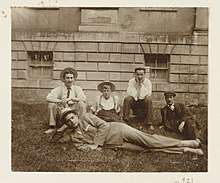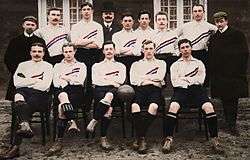Dolf Kessler
Geldolph Adriaan "Dolf" Kessler (2 April 1884 – 21 August 1945) was a Dutch footballer and industrialist. Kessler – along with brother Boeli and cousins Tonny and Dé – played club football for amateur side HVV Den Haag. Kessler also won three caps for the Dutch national side between 1905 and 1906.
 | |||
| Personal information | |||
|---|---|---|---|
| Full name | Geldolph Adriaan Kessler | ||
| Date of birth | 2 April 1884 | ||
| Place of birth | Batavia, Dutch East Indies | ||
| Date of death | 21 August 1945 (aged 61) | ||
| Place of death | Velsen, Netherlands | ||
| Senior career* | |||
| Years | Team | Apps | (Gls) |
| HVV Den Haag | |||
| National team | |||
| 1905–1906 | Netherlands | 3 | (0) |
| * Senior club appearances and goals counted for the domestic league only | |||
Family Background
Kessler was born in a very wealthy family from The Hague, the oldest son of six children. His father Jean Baptiste August Kessler (1853–1900) was the first director of the Koninklijke Maatschappij tot exploitatie van Petroleumbronnen in Nederlandsch-Indië (K.N.M.E.P.) (Royal Dutch Society for the exploitation of Petroleumsources in the Dutch East-Indies), which would eventually turn into the Koninklijke Nederlandse Petroleum Maatschappij (Royal Dutch Petroleum Company), now named Royal Dutch Shell.
Football career

Dolf made his debut as a football player at seventeen years of age, at the Hague football club HVV. At first he stood leftback, later he was a right winger. At HVV he became national champion four times between 1901 and 1905. On 30 April 1905 he was captain during the first official interland of the Dutch national team.[1] They beat Belgium with a 4–1 score.[2] The second interland and first home match also saw Kessler leading the team. For his third and last interland in 1906 Dolf had passed the captaincy on to Kees Bekker. Kessler seriously considered a career in football until later that year he dislocated his knee, ending his career in football. Sports, however, remained important to him.[3]
Business career
In 1907 Kessler graduated from the Technische Hogeschool Delft (Delft University of Technology), as a mechanical engineer.[4] He got a job as secretary for Henri Deterding, who had succeeded Dolf's father as the director of the Royal Dutch Petroleum Company.[5] He worked for the company until 1915, when he left to look for a different job.[6] As Joost Jonker and Jan Luiten van Zanden write in A History of the Royal Dutch Shell, his fiancée, Elizabeth "Bep" Stoop (herself a daughter of a prominent oil explorer, Adriaan Stoop), "put his love for her to the test by asking him to choose between her and the Group."[7] His younger brother Jean Baptiste August "Guus" Kessler Jr., who had married Bep's cousin, Anna Francoise "Ans" Stoop, continued with the Royal Dutch and eventually rose to head their father's company.[8]
In 1918 Dolf joined the committee for the funding of the Hoogovens (Dutch Blast Furnaces).[9] In 1920 he became economical director and from 1924 on he was also the director-general.[10] He was considered a very innovative manager, steering the company through the difficult economic environment of the Great Depression; he also believed it was necessary to provide fair wages and establish a pension plan—unusual for that time.[11] "His drive, entrepreneurship, imagination and leadership secured Hoogovens a firm foothold in a very competitive industry at a very difficult time."[12] Dolf and his brother Guus, as leading figures in two major Dutch business concerns, at one point formed a joint venture between the Hoogovens and Royal Dutch Shell to combat a perceived threat to the oil business by IG Farben.[13]
Kessler would remain the director of Hoogovens until his death from a brain tumor in 1945, with a short break during the Second World War, when the Germans kept him hostage in camp Beekvliet in Sint-Michielsgestel.[14]
Personal life
Dolf and his wife Bep (1891–1968) had four sons and two daughters.[15] Their home, known as Slingerduin or the Villa Kessler, was built and designed in 1929 by the prominent Dutch architect Hendrik Wouda (1885–1946), a follower of Frank Lloyd Wright.[16] They owned of one of the few known paintings by Hercules Seghers (1589/90–1637/38)--"River Valley" (1620)--which now is displayed by the Mauritshuis Museum (Royal Picture Gallery) in The Hague.[17][18]
Kessler was an uncle of the Dutch diplomat and historian Max Kohnstamm (1914–2010), with whom he was interned at camp Beekvliet in Sint-Michielsgestel; they became quite close there despite the difference in age.[19] The American journalist Glenn Kessler is one of his grandchildren.[20]
In 2016, the Rijksmuseum published, as part of its Studies in Photography series, "Around the World in 87 Photographs: Dolph Kessler's Grand Tour, 1908," by Mickey Hoyle.[21] Kessler took photographs while traveling on business for Royal Dutch Shell with Deterding. His photographs, and the commentary he wrote to his mother, are described as an early example of a photographic travel journal, as very few people at that time were privileged to make such a journey.[22]
External links
- (in Dutch) Player profile at VoetbalStats.nl
- (in Dutch) KESSLER, Geldolph Adriaan (1884–1945), Biographical Dictionary of the Netherlands
- (in Dutch) Photographs by Geldolph Adriaan Kessler, 1895–1913, housed at the Nederlands Rijksmuseum
- (in Dutch) Kessler family archives, with extensive letters and speeches by Geldolph Adriaan Kessler
- (in Dutch) Photographs of Geldolph Adriaan Kessler, E.M.L. Kessler-Stoop and children
- River Valley (1620) by Hercules Seghers
References and sources
References
- Player profile at VoetbalStats.nl
- Dutch Biographical Dictionary.
- de Clercq 2010, p. 86, "Bep Kessler-Stoop: Het is al Oprechtheid en Oorssponkelijkheid"
- Dutch Biographical Dictionary.
- Gerretson 1953, p. 173, Vol. 2.
- Jonker 2007, p. 356, Vol. 1.
- Jonker 2007, p. 357, Vol. 1.
- Jonker 2007, p. 487, Vol. 1.
- Dutch Biographical Dictionary.
- Dutch Biographical Dictionary.
- De Vries 1968, pp. 295–296
- Jonker 2007, p. 357, Vol. 1.
- Buchanan 2006, p. 386
- Dutch Biographical Dictionary.
- Dutch Biographical Dictionary.
- de Clercq 2010, p. 91, "Bep Kessler-Stoop: Het is al Oprechtheid en Oorssponkelijkheid"
- Frick Art Reference Library: Provenance, sold in 1969 by estate of E.M.L. Kessler-Stoop, IJmuiden, and bought with the help of the Vereniging Rembrandt, the Prince Bernhard Fund, the Koninklijk Nederlandse Hoogovens en Staalfabrieken N.V. (Successors of the Royal Netherlands Blast Furnaces and Steel Foundry), IJmuiden, and the Johan Maurits van Nassau Fondation, for the Mauritshuis
- Kessler-Stoop painting also referenced in Leo C. Collins, Hercules Seghers, University of Chicago Press, 1953
- de Clercq 2010, p. 105, "Bep Kessler-Stoop: Het is al Oprechtheid en Oorssponkelijkheid"
- New York Times 19 September 1988 – Cynthia Rich and Glenn Kessler marry
- – Nieuw: Around the World in 87 Photographs: Dolph Kessler's Grand Tour, 1908
- Hoyle 2016, p. iv
Sources
- Zanden, Jan Luiten van; Joost Jonker; Stephen Howarth; Keetie Sluyterman (2007). A History of Royal Dutch Shell. Oxford University Press. ISBN 978-0-19-929877-8.
- de Clercq, Daan; Saskia Everts; Michaja Langelaan; Ellen Stoop; Jet van Voorst Vader-Duyckinck Sander (2010). Uit Een Bron van Weelde: Het leven van de Erven Stoop [From a Source of Wealth: The Lives of the Stoop Heirs]. Stichting Stoop-van Deventer.
- De Vries, Joh. (1968). Hoogovens IJmuiden, 1918–1968.
- Buchanan, Brenda, ed. (2006). "Ernst Homburg: 'Explosives from Oil: The Transformation of Royal Dutch/Shell during World War I from Oil to Petrochemical Company'". Gunpowder, Explosives and the State: A Technological History. Ashgate Publishing Company. ISBN 978-0754652595.
- Gerretson, F.C. (1953). Geschiedenis der Koninklijke [History of the Royal Dutch]. E.J. Brill.
- Hoyle, Mickey (2016). Around the World in 87 Photographs: Dolph Kessler's Grand Tour, 1908. Rijksmuseum. ISBN 978-9491714634.
- KESSLER, Geldolph Adriaan (1884–1945), Biographical Dictionary of the Netherlands
- Kessler player profile at VoetbalStats.nl
Publications
- E.M.L. Kessler-Stoop, Terugblick op het leven en de persoon van Geldolph Adriaan Kessler ("Looking back on the life and person of Geldolph Adriaan Kessler"), privately printed collection of letters, The Netherlands, 175 pages.
- Nicolette Kessler-Leemans and Beppe Kessler, Tussen Moeder en Zoon: Briefwisseling Margo Kessler-deLange en haar zoon Dolph, 1901–1938 ("Between Mother and Son: Correspondence from Margo Kessler-DeLange to her son Dolph"), privately printed collection of letters, The Netherlands, 423 pages, 2004.
- Janneke van Gool, G.A. Kessler: Innovatief ondernemerschap bij Hoogovens ("G.A. Kessler, Innovative Entrepreneurship at Hoogovens"), thesis for economic and social history, University of Nijmegen, 1998.